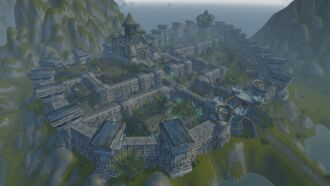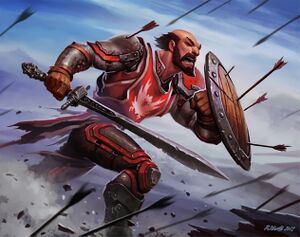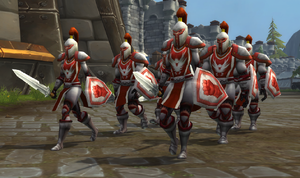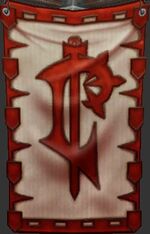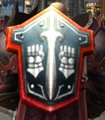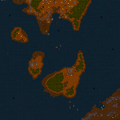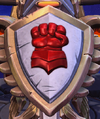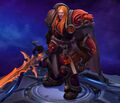Stromgarde (kingdom)
- This article is about the human kingdom. For the warfront, see Battle for Stromgarde. For other uses, see Stromgarde (disambiguation).
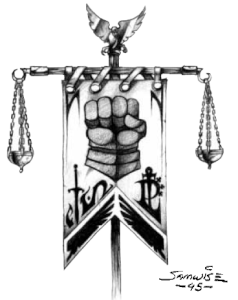 | |
| Main leader |
|
| Formerly | See below |
| Secondary leaders |
|
| Formerly |
|
| Race(s) |
|
| Formerly |
|
| Capital | Stromgarde Keep |
| Other major settlements | See below |
| Formerly | Tol Barad |
| Government |
Hereditary monarchy (Trollbane family) |
| Sub-group(s) | Stromgarde's military |
| Affiliation | Alliance, Church of Light |
| Formerly | Independent, Forsaken, Alliance of Lordaeron, Arathorian Empire |
| Status | Active |
| Reputation | |
| Tabard |
 |
“Since the founding of our glorious empire, the path to valor has always been drenched with the blood of heroes.”
Stromgarde, officially the kingdom of Stromgarde;[4] is one of the seven human nations in the Eastern Kingdoms, and is located on the site of the original capital of Arathor, Strom, in the Arathi Highlands. Stromgarde is all that remains of the mighty human Arathorian Empire. The national color of Stromgarde is red, and its symbols are a closed fist and a bird with its wings spread.
During the Second War, King Thoras Trollbane pledged his kingdom to the Alliance of Lordaeron against the Old Horde. However, the nation rapidly declined following the Third War, losing control of much of its territories and capital city after Thoras was murdered by his own son. In the aftermath, Prince Galen was unable to repel an invasion of the combined Syndicate, Boulderfist, and Witherbark forces. The city fell into ruins, with only a single district still held by the end of it; leading to the establishment of Refuge Pointe and the League of Arathor, locked in battle with the Defilers over control of Arathi Basin.
At some point after the Cataclysm, Stromgarde became an independent kingdom ruled by the undead King Galen Trollbane who betrayed the Forsaken.[2] This new position was short-lived as the Knights of the Ebon Blade killed Galen after his betrayal and raised King Thoras as one of the Four Horsemen. During the Fourth War, Stromgarde Keep was rebuilt by the Stromic people, and Danath Trollbane finally returned after many years far from home to reclaim his family's lands and bring his nation back into the Alliance. Unfortunately, the Arathi Highlands became one of the warfronts between the two great powers of the Alliance and the Horde, resulting in the Battle for Stromgarde. Nevertheless, Danath and the Alliance commanders eventually claimed victory, bringing peace to Stromgarde at last.[5][6]
History
Arathorian Empire
- Main articles: Arathor, Stromgarde Keep
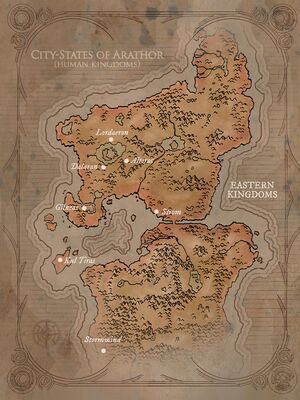
Around 2,800 BDP, the city of Stromgarde was founded by the Arathi tribe of humans in the Arathi Highlands during the Troll Wars. Originally named Strom, the city became the capital of the great Arathorian Empire, and under the reign of King Thoradin, word of Strom quickly spread among the early human tribes across the continent, and many traveled to the city for safety. 2,700 years BDP, following the peak of that empire's power, many of its citizens left to found other cities, including Dalaran, Lordaeron, Alterac, and Stormwind. Many of these newer cities began to attract settlers at an astonishing rate, and it was only a matter of years before the once-powerful Arathi Empire was splintered into seven distinct human nations. Around 1,200 years BDP, Strom was no longer the center of the human lands, and it was during this time that the leaders of the remaining warriors changed its name to Stromgarde.[7] After the departure of Thoradin's ruling descendants, the capital was left in the hands of a few ruling families who were too stubborn to leave, including the Trollbane family, children of the legendary and feared general Ignaeus Trollbane who ascended the throne. While they rebuilt the crumbling infrastructure, however, the city would never regain its former glory.[8]
Before the Great Wars
For generations, the Trollbane family and their soldiers fought the Witherbark trolls, considering them as sworn enemies of Stromgarde and a curse upon the land of Arathi.[9]
75 years prior to the First War, King Barathen Wrynn of Stormwind sent envoys to beseech Lordaeron, Stromgarde, and the other human kingdoms for aid during the Gnoll War. But they would not send assistance, seeing no advantage in helping the smaller, rural nation, as Stormwind was self-sufficient and trade with the other kingdoms was rare.[10]
Before the coming of the orcs, the human kingdoms of Lordaeron faced challenges and obstacles from each other as the games of politics played out.[11] Amidst those nations, there were no two rivals like Alterac and Stromgarde. The proximity of the two and the apparent ambiguity of their mountain borders had led to several wars and skirmishes. On more than one occasion, King Thoras Trollbane led the armies of Stromgarde into battle against the honorable General Hath of Alterac.[12] The tension of their repeated discord was noticeable at the Alliance summit as Perenolde glared at Trollbane.[13] It is conceivable that this discord had alienated Alterac from the other nations who had positive relations with Trollbane, and would contribute to Perenolde's willingness to turn against his allies.
Following the First War and destruction of Stormwind City, the Council of Seven Nations was formed by Sir Anduin Lothar and King Terenas Menethil II with the intent of convincing the other kingdoms to band together to repel the invading Orcish Horde. However, divisions widened between the kings, and the arguments grew so heated that Gilneas and Alterac threatened to abandon the council entirely. Nevertheless, this diplomatic incident was avoided when Turalyon presented himself with Prince Varian Wrynn at his side, and delivered an impassioned and charismatic speech of union to the assembly, which got through to even the most doubtful present. The council later voted unanimously to form the Alliance of Lordaeron, comprising all of humanity's kingdoms.[14]
Second and Third Wars
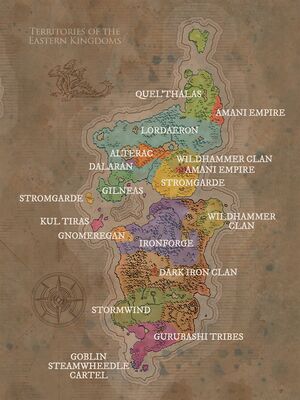
By the time of the Second War, Stromgarde was a harbor city[15] that controlled the Arathi Highlands and the island-fortress of Tol Barad.[16] Though not the largest, it was one of humanity's most powerful kingdoms. Led by King Thoras Trollbane, it was also a close and loyal ally of Lordaeron, and their mutual friendship would allow it to quickly join the Alliance of Lordaeron to stop the Horde.[17] At the beginning of the war, Stromgarde sent half of its standing army to join the main Alliance forces.[18] The rest of its army was occupied defending the Northlands from an orcish invasion through the dwarven realm of Khaz Modan.[19] The kingdom also sent several taskforces behind enemy lines, to siege Dun Modr[20] and attempt to wrest control of the Badlands from the orcs,[21] until its garrison at Tol Barad and its capital both fell under heavy attacks by the Black Tooth Grin clan.[15]
As the orcs viewed Tol Barad as an obstacle in their path to the Eastern Kingdoms, they mounted a ferocious counterstrike on the island. Unprepared for such aggression, the Stromgarde soldiers were expelled from Tol Barad, and the citadel was razed, a charred symbol of the Horde's brutal victory.[22] Most of the island's inhabitants were slaughtered, their home ravaged, and their remaining spirits crying out for vengeance.[23] Some Stromic people still survived,[24] but possibly as exiles since when Rhonin and his gryphon rider escort passed above the island they saw no human life on it.[25]
King Thoras Trollbane was also the first to become suspicious of Alterac's true allegiance, and quickly dispatched a force to investigate what was happening in that kingdom. They were able to discover that King Aiden Perenolde had made a pact with Warchief Orgrim Doomhammer, allowing the orcs to pass through some unguarded mountain passes, giving them free passage into Lordaeron. Consequently, King Thoras and his troops quickly dispatched the orcs stationed there and prevented further orc reinforcements from passing through.[12] With no sign of reinforcement and cornered by the Alliance and Lordaeron forces on one side, and Stromgarde troops on the other, the standing orc forces had to retreat from the Siege of Capital City.[26]
Shortly after the war, Turalyon spearheaded the efforts to rebuild the Eastern Kingdoms and gathered the kings, who agreed to pool their resources to mend their war-ravaged nations.[27] Stromgarde also built a military outpost along the borders of the Alterac Mountains, which was raided by the Horde of Draenor in order to get the Book of Medivh back from the Alteraci.[28] By the end of the war, Danath Trollbane was one of Stromgarde's most celebrated soldiers after acting as a great leader during the final battle for the liberation of Khaz Modan. A prominent mercenary veteran, he served as the military commander of Stromgarde and tactical advisor to Turalyon,[29][30] and was thus elevated to the position of Overseer of the orcish internment camp system based at New Stormwind.[31][32]
In the years that followed, a Stromic and Tirasian population of men formed the Baradin's Wardens in Tol Barad, an organization charged with ensuring that the deadly prisoners locked away in the mystic Baradin Hold never again walk free on Azeroth. They are a motley collection of soldiers with several prominent members claiming ancestry from Stromgarde.[33]
At some point, King Terenas Menethil II went on a diplomatic visit to Stromgarde, and was accompanied by Uther the Lightbringer and an unnamed bishop.[34]
King Thoras Trollbane later petitioned King Terenas to annex the eastern portion of Alterac's territory to Stromgarde in recognition of the latter's sacrifices and valor during the Second War. This created a great deal of political tension between the two powers, which was all the more tragic considering the friendship between Trollbane and Terenas.[35] The Alterac debate was a contributing factor when Stromgarde left the Alliance. Additionally, Trollbane had grown displeased at King Terenas' decision to not execute the captured orcs as the expense of maintaining the internment camps grew. He finally pulled out of the Alliance around the same time as Gilneas and Quel'Thalas,[36] in consequence of the liberation of the orcs from internment camps.[37]
During the Third War, Stromgarde managed to prevent the undead Scourge from ravaging through its lands. Prior to the Siege of Dalaran, Lady Jaina Proudmoore worked tirelessly to rally as many refugees as she could after she had been convinced by the mysterious Prophet that sailing west to Kalimdor was the only course to save humanity. When she set sail for Kalimdor, her forces included members from nearly every Alliance race, including humans from Stromgarde and other nations in the region. The kingdom also sent a detachment of troops, the Stromgarde Brigade, to accompany the Human Expedition across the sea.[38]
Despite this, the darkest hour of Stromgarde was yet to come. King Thoras was ultimately secretly murdered by his son, Prince Galen, who sought the throne of Stromgarde for himself.[39] However, the crown prince was unable to hold the kingdom together, as Stromgarde also came under siege by both the Syndicate and the Boulderfist ogres, the two forces winning several victories against the now weakened kingdom, and managing to occupy much of its terrain, including most of Stromgarde Keep.
When Stromgarde started to suffer a series of catastrophes, the town of Rustberg on Tol Barad was abandoned as its people were recalled home. It later became the base of a group of pirates that struck the towns along the shores of Baradin Bay.[24]
After the Third War
Though weaker than before, its population and territory greatly diminished, Stromgarde was still remembered as the starting point of humanity. Though much of the capital was lost, the Stromgarde army maintained a base of strategic operations at the crevasse known as Refuge Pointe in the Highlands, as well as portions of the devastated capital city itself, then occupied by ogres and the criminals of the Syndicate.[40] The Argus Wake, which secretly controlled the Syndicate, also planned to take over the capital to prepare the way for the Burning Legion's next invasion of Azeroth.[41]
The forces of Stromgarde formed the League of Arathor, which fought to free the rest of the Arathi Highlands, the Arathi Basin, and its many resources from the hands of the Forsaken Defilers as well as the Horde forces from Hammerfall. With the Stromgarde Militia, Prince Galen Trollbane ruled from the Trollbane family crypt, which safeguarded several ancient artifacts, until his own demise at the hands of the Horde.[42] During the invasion of the capital, Archmage Trelane attempted to defend the Tower of Arathor, but was unsuccessful and exiled himself to Stormwind City.[43]
After Thandol Span and its dwarven troops suffered heavy damage due to a Dark Iron attack,[44] Rhag Garmason pleaded Captain Nials to spare some Stromic soldiers to help them reclaim Dun Modr and the Thandol Span. However, the captain had no choice but to refuse, since honor and duty required them to not leave the Highlands until they reclaimed their fallen kingdom.[45]
During the invasion of Outland, Danath Trollbane learned of the fate of his beloved Stromgarde, and wished to restore it to its former glory once his duty in Outland was done.[46]
After the Cataclysm, Galen was raised into undeath by the Forsaken, seemingly pledging allegiance to Sylvanas Windrunner while her forces reclaimed Trol'kalar and raised his former citizens into undeath.[47] At the same time, adventurers had to report to Refuge Pointe by order of King Varian Wrynn, in order to fight the forces that invaded Stromgarde, and to help redeem the honor of the ancient kingdom.[48]
Legion
By the time of the Burning Legion's third invasion, Prince Galen Trollbane had turned his back on Sylvanas Windrunner and the Forsaken and declared Stromgarde an independent undead kingdom. After crowning himself king, Galen took Trol'kalar and reclaimed the capital with its former citizens as his guard, managing to repel the Boulderfist clan ogres and the Syndicate. When the Deathlord and the Knights of the Ebon Blade approached Galen to request access to his father's tomb, King Galen agreed on the condition that they help secure the city against the Witherbark trolls still encroaching upon it.[2][49] However, after the trolls were eliminated, Galen refused to hold up his end of the bargain and ordered the death knights killed. Instead, the death knights slew Galen and raised King Thoras Trollbane into undeath as a member of their new Four Horsemen. The newly-raised Thoras then gave up his kingdom for lost and joined the Ebon Blade to save Azeroth from the invading demons.[39]
Battle for Azeroth
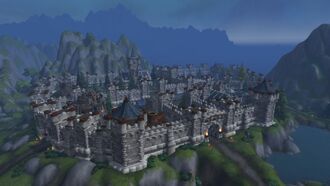
After the Battle for Lordaeron, the Arathi Highlands became a warfront between the Alliance and the Horde. The citizens of Stromgarde returned home and, led by Danath Trollbane, the Stromgarde army defended its city during the Battle for Stromgarde. After their construction, both Highlands Mill and Galson's Lode became the primary source of lumber and iron for the kingdom.[50] In order to keep the army funded, fed, and ready to fight, the Alliance coffers funded most of the war effort with money, food, and supplies, the rest being financed by donations and the work of its citizens.[51]
While the Alliance planned to use Stromgarde to cut off the Horde forces from Silvermoon City in the north, as holding a firm line in Arathi was critical to the Alliance's continued occupation of Lordaeron,[52] the Horde aimed to use it as a staging ground to break north, preventing the Alliance from building up to attack Gilneas.[53] During the invasion, various heroes of the Alliance arrived to defend the city, such as Turalyon with the Order of the Silver Hand and Army of the Light, Muradin Bronzebeard with the forces of the united dwarven kingdom; and Danath heading the League of Arathor as well. They faced off against champions of the Horde, such as Lady Liadrin and her Blood Knights, Rokhan and his Darkspear trolls, and Eitrigg leading the veterans of the Horde.
The battle ultimately ended in the Alliance's favor, with Stromgarde victorious.[54][6] This victory restored Stromgarde Keep as the capital of its eponymous kingdom, leaving the Horde stronghold of Ar'gorok in ruins, and the various settlements of the kingdom in the hands of the Alliance once more. Following the Alliance victory, the soldiers returned home, leaving only a few behind as a precaution.[55] When Mathias Shaw presented himself to Stromgarde during his mission for King Anduin Wrynn, Danath blessed him to inspect the Sanctum and the Crypt.[56]
After the Fourth War, Danath's outriders spotted an armed and cloaked woman traveling with a group of Horde refugees throughout the Arathi Highlands, and the new leader of Stromgarde subsequently informed his old friend Alleria Windrunner, as she and Turalyon were riding through the region searching for the whereabouts of her sister Sylvanas Windrunner.[57]
People and culture
“Honor and duty require that we do not leave the Highlands until Stromgarde raises the mighty banner of the King once again.”
The correct demonym for people coming from Stromgarde is "Stromic".[58]
Stromgarde shares its red signature color with the Alteraci, the human tribe Ignaeus Trollbane hailed from.[59] The kingdom is also referred to as the "Eagle and Fist".[60]
A mountain kingdom, its people grew up learning to climb the rock faces and scale the peaks, to the point that they sometimes prefer to simply climb up mountains by themselves rather than use the available roads and passes to travel.[12] As natives of a cold mountainous region, they also prefer action over talk.[61] Forearm handshake is a common gesture of friendship with the soldiers of Stromgarde.[62] According to the laws of Stromgarde, they are honorbound to repay someone who has saved their life, a tradition shared with the human of Stranglethorn Vale.[63]
King Thoras Trollbane was known as one of the greatest warriors the world of Azeroth has known, and his people loved him as his enemies feared him.[39] He was also willing to admit he'd been wrong, which might have been one of the traits that had made him so beloved by his people when he ruled.[62]
The Church of the Holy Light spread the faith of the Holy Light in Stromgarde,[64][65] as indicated by the chapel in the Sanctum, the Stromgarde priests, and the church' symbols in their cemeteries.
Like the other kingdoms before the Third war, the Stromic people practice the traditional Hallow's End celebrations each year.[66] As the major spring celebration in Lordaeron,[67] Stromgarde also celebrates the Noblegarden and it is customary for its nobles and lords to hide coins, candy, and the occasional treasures within special eggs painted to look like wildflowers, which are then scattered in the capital and towns for the citizenry to find.[68] They are also seen celebrating other holidays such as the Midsummer Fire Festival, Brewfest, Harvest Festival, Remembrance Day, and the Winter Veil.
Like the other realms, the kingdom of Stromgarde can apply the death penalty for its criminals, the task being accomplished by an executioner.
Notable people
Notable leaders
| History | Interlude | ||||||||||||||||||||||||||||||||||||||||||||||||||
|---|---|---|---|---|---|---|---|---|---|---|---|---|---|---|---|---|---|---|---|---|---|---|---|---|---|---|---|---|---|---|---|---|---|---|---|---|---|---|---|---|---|---|---|---|---|---|---|---|---|---|---|
| Ruler | King Thoras Trollbane | Prince Galen Trollbane | None | King Galen Trollbane | None | Danath Trollbane | |||||||||||||||||||||||||||||||||||||||||||||
Military forces
- Main article: Stromgarde army
The crimson-clad soldiers of Stromgarde are known for their martial discipline in battle and have proven themselves in the Second War; none could argue with their determination, as they were able to hold off the entire Old Horde armies on their own, allowing the rest of the Alliance of Lordaeron to mobilize.[69] Possessing a long history of warfare against the trolls, their warriors are well prepared to engage in open combat with all enemies of humanity.[70] Each of their soldiers is well-versed in mountaineering as in combat,[71] and were recognized as loyal, steadfast allies.[72]
- Stromgarde Militia
- League of Arathor
- Stromgarde Brigade (disbanded)
- Stromgarde Defenders

- Stromgarde Snipers Company

Territories and outposts
-
- Highlands Mill
- Galson's Lode
- Circle of Elements
- Northfold Manor †
- Go'Shek Farm (formerly)
- Arathi Basin
- Trollbane Hall
- Defiler's Den (formerly)
-
- Tol Barad (formerly)
- Baradin Hold (formerly)
- Ironclad Garrison (formerly)
- Warden's Vigil (formerly)
- Slagworks (formerly)
- Baradin Hold (formerly)
- Tol Barad Peninsula (formerly)
- Rustberg Village (formerly)
- Tol Barad (formerly)
In Warcraft II
Leader: Thoras Trollbane
Nation Color: Red
Background: The kingdom of Stromgarde retains a strict martial philosophy which makes it a highly regarded addition to the Alliance. Situated amongst the foothills of the Alterac Mountains, Stromgarde serves as a sentinel against any invasion across the Orc-controlled borders of Khaz Modan. Possessing a long history of warfare against the Trolls, the warriors of Stromgarde are well prepared to engage in open combat with all enemies of humanity.[70]
In Warcraft III
A Warcraft III map is spelled "Stromguarde". This city is controlled by a group of bandits and wizards. Entering it at night could be very dangerous. The tileset is called "Cityscape".
In the RPG
During the Second War, Lordaeron's opposite was Stromgarde; its leader, Thoras Trollbane, led his kingdom with a strict, martial philosophy. While Lordaeron brought the priests into the Alliance of Lordaeron, Stromgarde brought the warriors. This kingdom borders Khaz Modan, and served as the first area of defense from land-based attacks for the humans. Stromgarde left the Alliance after the Second War, upset with certain political decisions.[73]
The Stromgarde Defenders and the Stromgarde Snipers Company are the forces protecting Stromgarde. Their determination and courage are known throughout Azeroth as some of humanity's greatest fighters. In battle, the footmen would march to face the enemy in tight ranks with broadswords and shields. The famed knights of Stromgarde are used as shock troops to support these warriors especially against ogre and Syndicate forces. The Stromgarde Snipers Company, made up of dwarven rifleman, provide them with covering fire. Captain Dathanor Cromwell commands the infantry unit, while Captain Ariana Thesslocke leads the cavalry unit.[74]
Film universe
Stromgarde participated in the council that would eventually lead to the creation of the Alliance.
Notes and trivia
- Some buildings on the remastered Arathi Basin bear the Stromgarde iconography, and some buildings' roofs are a faded red.
- In Of Blood and Honor, the banner representing Stromgarde was described as black with a red-gauntleted fist.[75]
- Stromgarde's fist symbol looks similar to many depictions of Keeper Tyr's silver hand, but the two have never been identified as having any connection.
- The Stromgarde's banners raised when Danath is the Warfront commander reuse the Scarlet Onslaught banner model, likely because of the red Lordaeron "L", which was used on Stromgarde's official banner.[76][77]
- King Genn Greymane visited Stromgarde at one point, when Gilneas was a powerful nation and Stromgarde's star was waning.[78]
- The first Captain General of the Scarlet Crusade Orman was a citizen of Stromgarde.
- Makasa Flintwill's ancestors come from Stromgarde.[63]
- Fallen footmen wearing Stromic uniforms can be summoned using
 [Baradin Footman's Tags].
[Baradin Footman's Tags]. - When Korialstrasz visited Nozdormu in the Caverns of Time, he noticed an armor from the reign of the first king of Stromgarde littered on a small sand dune.[79]
- Tides of Darkness states that Stromgarde is a mountain kingdom with a strong mountaineering culture, to the point that native Stromic people sometimes prefer to simply climb up mountains by themselves rather than use the available roads and passes to travel. The book also emphasized Stromgarde's geographical closeness with Alterac.[12] World of Warcraft depicts the Arathi Highlands as more hilly than really mountainous, and Stromgarde Keep as being away from the northern reaches of the realm, though the Highlands themselves are surrounded by mountains. World of Warcraft also has the Alterac Mountains two zones away from the Arathi Highlands, though that is only a modern perception, as before the First War Alterac owned land east of the Darrowmere River, thus sharing a mountainous border with Stromgarde at that time.[80]
- Stromgarde is also the setting for the popular fan machinima Return which won an award at BlizzCon.
- The area outside the walls of Stromgarde is also used in South Park's "Make Love, Not Warcraft" episode.
- Stromgarde is referenced by several skins in Heroes of the Storm.
- One of the tints for Arthas' Crown Prince skin is the red-tinted "Stromgarde Prince Arthas".
- One of the tints for Varian's Footman skin (no longer available) is "Stromgarde Footman Varian", which gives him red and white armor and causes his shield to bear the red gauntlet of Stromgarde.
- One of the tints for Varian's Grand Marshal skin was formerly named "Stromgarde Marshal Varian". A later patch renamed it to "Stormpike Marshal Varian".
Gallery
Stromgarde's symbol on the Overlord's Shield.
Stromgarde and its defenders in Warcraft II.
Stromgarde on a map of Warcraft III.
Stromgarde seen in a map of the Warcraft film.
Shield seen on a motorbike in Heroes of the Storm.
Varian Wrynn Stromgarde Footman in Heroes of the Storm.
Crown Prince Stromgarde Arthas in Heroes of the Storm.
See also
References
- ^ Archived page
- ^ a b c

 [10-45] Our Oldest Enemies
[10-45] Our Oldest Enemies
- ^ Danath Trollbane#Valley of Heroes monument
- ^ Of Blood and Honor, pg. 74
- ^ BlizzCon 2019: WoW Q&A Panel
- ^ a b Turalyon#Stormwind Keep
- ^
 [The Seven Kingdoms]
[The Seven Kingdoms]
- ^ World of Warcraft: Chronicle Volume 1, pg. 142
- ^

 [10-45] Death... and Decay
[10-45] Death... and Decay
- ^ World of Warcraft: Chronicle Volume 1, pg. 160
- ^ Arthas: Rise of the Lich King, pg. 27 & 31
- ^ a b c d Tides of Darkness, chapter 16
- ^ Tides of Darkness, chapter 3
- ^ World of Warcraft: Chronicle Volume 2, pg. 152 - 153
- ^ a b The Fall of Stromgarde (WC2 Orc)
- ^ File:Chronicle2 Eastern Kingdoms Before the First War.jpg
- ^ World of Warcraft: Chronicle Volume 2, pg. 142
- ^ Tides of Darkness, pg. 260
- ^ Tol Barad (WC2 Human)
- ^ Tol Barad (WC2 Orc)
- ^ The Badlands (WC2 Orc)
- ^ Tol Barad - Game Guide
- ^ The Well of Eternity, chapter 1
- ^ a b Ask CDev#Ask CDev Answers - Round 3
- ^ Day of the Dragon, chapter 8
- ^ Tides of Darkness, pg. 322-323
- ^ World of Warcraft: Chronicle Volume 2, pg. 176
- ^ Alterac (WC2 Orc)
- ^ Ultimate Visual Guide, pg. 75
- ^ World of Warcraft: Ultimate Visual Guide, Updated and Expanded, pg. 87
- ^ Warcraft II: Beyond the Dark Portal manual, Legends of the Land, Danath
- ^ World of Warcraft: Chronicle Volume 2, pg. 177, 184
- ^ Baradin's Wardens. Archived from the original on 2013-05-21.
- ^ Arthas: Rise of the Lich King, chapter 4
- ^ Day of the Dragon, pg. 6
- ^ Warcraft III: Reign of Chaos Game Manual, pg. 67
- ^ World of Warcraft: Chronicle Volume 3, pg. 34
- ^ World of Warcraft: Chronicle Volume 3, pg. 65
- ^ a b c

 [10-45] The King Rises
[10-45] The King Rises
- ^ Arathi Basin#Official overview
- ^
 [Decrypted Letter]
[Decrypted Letter]
- ^
 [42] Sigil of Trollbane
[42] Sigil of Trollbane
- ^
 [32] Malin's Request
[32] Malin's Request
- ^
 [30] The Dark Iron War
[30] The Dark Iron War
- ^ a b
 [31] Plea To The Alliance
[31] Plea To The Alliance
- ^ Danath Trollbane's quotes in Honor Hold
- ^
 [10-30] The Forsaken Trollbane
[10-30] The Forsaken Trollbane
- ^
 [10-30] Hero's Call: Arathi Highlands!
[10-30] Hero's Call: Arathi Highlands!
- ^

 [10-45] Death... and Decay
[10-45] Death... and Decay
- ^
 [50] Touring the Front
[50] Touring the Front
- ^
 [50] Warfront Contribution
[50] Warfront Contribution
- ^
 [50] Back to Boralus
[50] Back to Boralus
- ^ BlizzCon 2017 World of Warcraft Gameplay and Systems Deep Dive
- ^ BlizzCon 2019: Q&A panel
- ^ World of Warcraft: Exploring Azeroth: The Eastern Kingdoms
- ^ World of Warcraft: Exploring Azeroth: The Eastern Kingdoms, pg. 66, 68
- ^ Shadows Rising, chapter 9
- ^ Sean Copeland on Twitter: "Lore from Chris Metzen and Micky Neilson! Alteraci (“alterackee”), Lordaeronian, Stromic, Dalaranian, Stormwindian. BOOM." March 10, 2014
- ^ Saga of the Valarjar: Strom'kar, the Warbreaker
- ^
 [40] Eagle's Fist
[40] Eagle's Fist
- ^ Day of the Dragon, chapter 6
- ^ a b We Ride Forth
- ^ a b World of Warcraft: Traveler, chapter 12
- ^ World of Warcraft: Chronicle Volume 2, pg. 126
- ^ Brother Atticus
- ^

 [Tricks and Treats of Eastern Kingdoms]
[Tricks and Treats of Eastern Kingdoms]
- ^ Arthas: Rise of the Lich King, chapter 7
- ^ Noblegarden's event description
- ^ Day of the Dragon, pg. 5
- ^ a b Warcraft II: Tides of Darkness manual, Nations of the Alliance, Stromgarde
- ^ Tides of Darkness, chapter 16
- ^ Day of the Dragon, chapter 1
- ^ Alliance Player's Guide, pg. 158
- ^ Lands of Conflict, pg. 90
- ^ Of Blood and Honor, chapter 5
- ^ Warcraft II artwork
- ^ Chronicle Volume 2 artwork
- ^ Before the Storm, chapter 28
- ^ Day of the Dragon, chapter 12
- ^ File:Chronicle2 Eastern Kingdoms Before the First War.jpg
| |||||||||||||||||||

